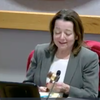‘The Power of Plus’: Russo was healed by telling the stories of courageous women
Gianluca Russo became a journalist because he likes telling stories.
He has just published his first book, “The Power of Plus: Inside Fashion’s Size-Inclusivity Revolution.”
The book is “For the women who changed my life and the people who saved it.”
“I wanted to dedicate it to the women the book is about,” Russo said of the plus-size models he interviewed, explaining the first line of the dedication.
“But then I really stepped back and I thought … What’s the purpose here? I had gone through such a difficult period in life, from age 18 until I was about 21, where I felt like I had no purpose, where I felt I was lost.”
Talking to the courageous women who shared their stories, Russo said, helped heal his own wounds.
He writes in the introduction to his book about dieting since he was younger than 10. “We give in to society’s unattainable beauty standards, and unconsciously succumb to the pressure to be ‘thin enough’ or die trying. It’s time to take back the narrative,” Russo writes.
As a Guilderland High School student, Russo was involved in both acting and journalism. He sees each as a way of storytelling and his next book, a novel based on his high school experience, is “a theater kid novel,” he says in this week’s Enterprise podcast.
He’s also working on another nonfiction book, on body diversity on Broadway.
What drew him to write his first book was the revolution he was witnessing in Teen Vogue, a magazine he loved. As a journalism student at the University at Albany, he also worked as a writer for Teen Vogue.
After graduating, he read “More Than Enough,” by Elaine Welteroth, the former editor of Teen Vogue.
“It just absolutely changed my life,” said Russo, who is now 24. He deeply admires Welteroth and the way she made “a global change in the magazine industry.”
“I wanted to create something that felt like a piece of me and felt like an introduction of who I am into the world,” said Russo.
“I wanted to do something bigger than just writing magazine articles … I wanted to do something that felt like a celebration of everyone who forced this conversation around body diversity …. This book is a celebration of how far we’ve come, but a reminder of how much further we need to go.”
His book, published by Chicago Review Press, has 11 chapters interspersed with three roundtable discussions in which well-known bloggers, models, advocates, and content creators have candid conversations, responding to questions posed by Russo.
“The roundtables for me,” said Russo, “represent the book in three different sections: the past, the present, and the future … The first one really talks about an overview of classic fashion, how three crucial people have been able to make change …
“The second one really talks about where we’re at right now in inclusive fashion, the issues we’re facing, how we’re tackling them. The last one talks about a frontier that isn’t yet tackled, which is plus-size menswear, and how we can push forward and include that in the future.”
While history is woven into the opening chapters and the voices of famous models are present throughout, much of the book’s perspective is personal.
In the chapter “Runways and Redemption,” Russo writes about covering his first Fashion Week. He was an intern in New York City, tweeting about Fashion Week when an editor asked if he’d cover it for NYLON.
Russo ended up in the front row. “This was what I was fighting for, to have access to spaces like these and still, in the moment, I felt out of place,” he said. At age 20, he described the juxtaposition of being with people he greatly admired yet feeling out of place.
“There’s a difference between opening the door for people to attend events like Fashion Week and saying we’re inclusive of all and really meaning it.”
Russo starts another chapter with this provocative sentence: Had it not been for Victoria’s Secret, I wouldn’t have a fashion career.
During his last semester at UAlbany, as he was writing for Teen Vogue, he recalled the former CEO of Victoria's Secret “made some very hateful comments — and finally the brand was getting attacked in the way many thought they deserved to be for many years for being so exclusionary.”
It was the day before Thanksgiving break and Russo reached his editor by email although she wasn’t in the office; she gave him an hour to write his piece.
“I remember this moment perfectly because it felt so big to me …. I’d be the first one covering it, but I knew what I was going to say — I was going to talk about how exclusionary they were and really how they had impacted so many people …
“It was a pivotal moment for me,” Russo recalled as before he had been writing “shopping roundups and listicles and all that kind of generic stuff.”
His piece was widely shared.
After graduating and reading Welteroth’s book, Russo wrote a series of features on plus-size fashion that got a lot of attention online, and led to a literary agent contacting him.
“For me, the story was all about community,” said Russo.
In the book, he makes a point of using the word “fat” rather than, say, “curvy.” Sticking to the word “fat,” he writes, “set the tone for the journalist I so desperately wanted to be, one who spoke truth, who spoke fire, who made people uncomfortable in the best way. A journalist on a mission to save lives and liberate others from the purgatory of fatphobia.”
“For me,” Russo said, “the word felt like a revolution.”
When he started writing his book, in 2018, the word “fat” was stigmatized but now it’s used at top fashion magazines, even in headlines, he said.
“We were able to normalize something that was a weapon … for so long. And I think that really shows the importance of taking a stand for what you know is right.”
Russo’s book notes a widely held statistic that 68 percent of women wear plus sizes.
“The problem with designers and brands right now,” Russo says, “is they don’t know how to reach them …. Brands don’t know how to get to them and to say, ‘You know, you’re welcome here … You can be part of this.’ Because for decades, they’ve been conditioned to believe that they can’t be part of this.
“They’ve shut their eyes to fashion, to shopping, to the possibility of feelling glamorous because they’ve been told since essentially their birth that they cannot be part of this because of the way they look.”
Russo concludes, “I want everyone to read this book. I think it’s about more than just whether or not you are a plus-size person in fashion. This is an issue that impacts everyone because we all know someone in our life who has felt othered because of their size and has felt kind of rejected because of the way they look.
“This,” he said, “is a conversation we can all be part of.”



